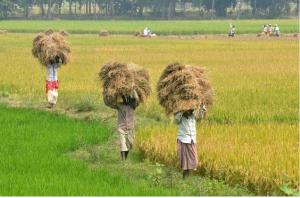Prospects for rice exports seem good!
 This year’s untimely rains have however helped, farmers in the rice belts of North, in states like Chattisgarh, Madhya Pradesh say, that that paddy output this year might be higher than the official estimates.
This year’s untimely rains have however helped, farmers in the rice belts of North, in states like Chattisgarh, Madhya Pradesh say, that that paddy output this year might be higher than the official estimates.
Rice, we must know is an export commodity these times and hence what is happening to the paddy growing segments is critical importance.
This year’s government target (FY17) is 108.50 million tonnes. Farmers says this target, both kharif and rabi taken into account might increase by 7.5 per cent. Sanket Thakur, Director, Chattishgarh Agricon Samithi, a non-government organisation working on agriculture in Central India has said that the rainfall has compensated for the initial dry season.
Says another farmers’s leader. Karamchand Asrani, President Madhya Pradesh Chawal Udyog Mahasangh that a major part of MP was hit by floods but still the state is set for a record paddy production. The production could be high as much as 25 per cent the farmer says. The untimely rains have helped the medium and long duration paddy crops. The good output of paddy is likely to keep the prices stable. While the production prospects are good, not so the optimism of the farmers who grumble about the Minimum Support Price, MSP which is four percent while the production costs have increased.
Of course, the most important point is that from a larger point of view it is the exports opportunities for the Indian paddy.
Traders says the exports are likely to go up this year. Though there is a sharp fall in the acreage of paddy, that is the basmati variety, the regions growing basmati are of course Punjab and Haryana, the rise in exports of other varieties of rice, there is a likelihood of rise in rice exports. Mohinder Pal Jindal, president, All India Rice Exporters’ Association says that there would be arise of 5-10 per cent in the basmati variety. These states export about 4 mt of basmati every year.
In non-basmati variety Chattisgarh exports over 1 million tonnes to African countries. The state plans to export this year 10 per cent more. Though over-all, the prospects for Indian agriculture, Indian rice exports are all seem good enough to entertain some optimism.
Over-all, the total countrywide rainfall in the official monsoon season (June to September) remained three percent below average. In some big states in the South, both Karnataka and Tamil Nadu had huge deficits and thus the Cauvery water dispute prolonged the agony for the people, not necessarily for the farmers. Trade between the two states suffered hugely.
Otherwise, over all the monsoon this year has not been bad, the kharif crop plantings has been fairly good and thus the government official machinery is satisfied and predicts a an all time high output of almost all crops. The agri minister expects a nine percent growth in the overall kharif grains.
Fine. A 60 per cent spurt or jump in the output of pulses and 40 per cent in oilseeds. Two critically import-dependent commodity groups are these only.
The 91, again critically important for agriculture and otherwise, major reservoirs has surged 25 per cent above the last year’s levels. It is just 2 per cent short of a previous 10 years’ average.
So, it looks fine? Not so from many other parameters’ points of view. The India Meteorological Department (IMD) has once again failed to get its long range monsoon prognosis right, right?
The short range forecasting capability has attained a distinctive improvement. Actual rainfalls have turned out to be well below the IMD’s forecasts. As much as nine per cent of its prediction point below. Farmers, those too Indian farmers are the most neglected lot from many points of view.
One the weather forecast. Second, assuming the monsoon rains are good, any bumper harvest means also a lower price prospect! This is the eternal dilemma of the Indian farmer!
Unless there is some assurance for a price support system in place the Indian farmers would continue to suffer. This is where a framing strategy is called for. Is there a farming strategy in place in India at present?
Even after all our talks about using the latest technology tools?